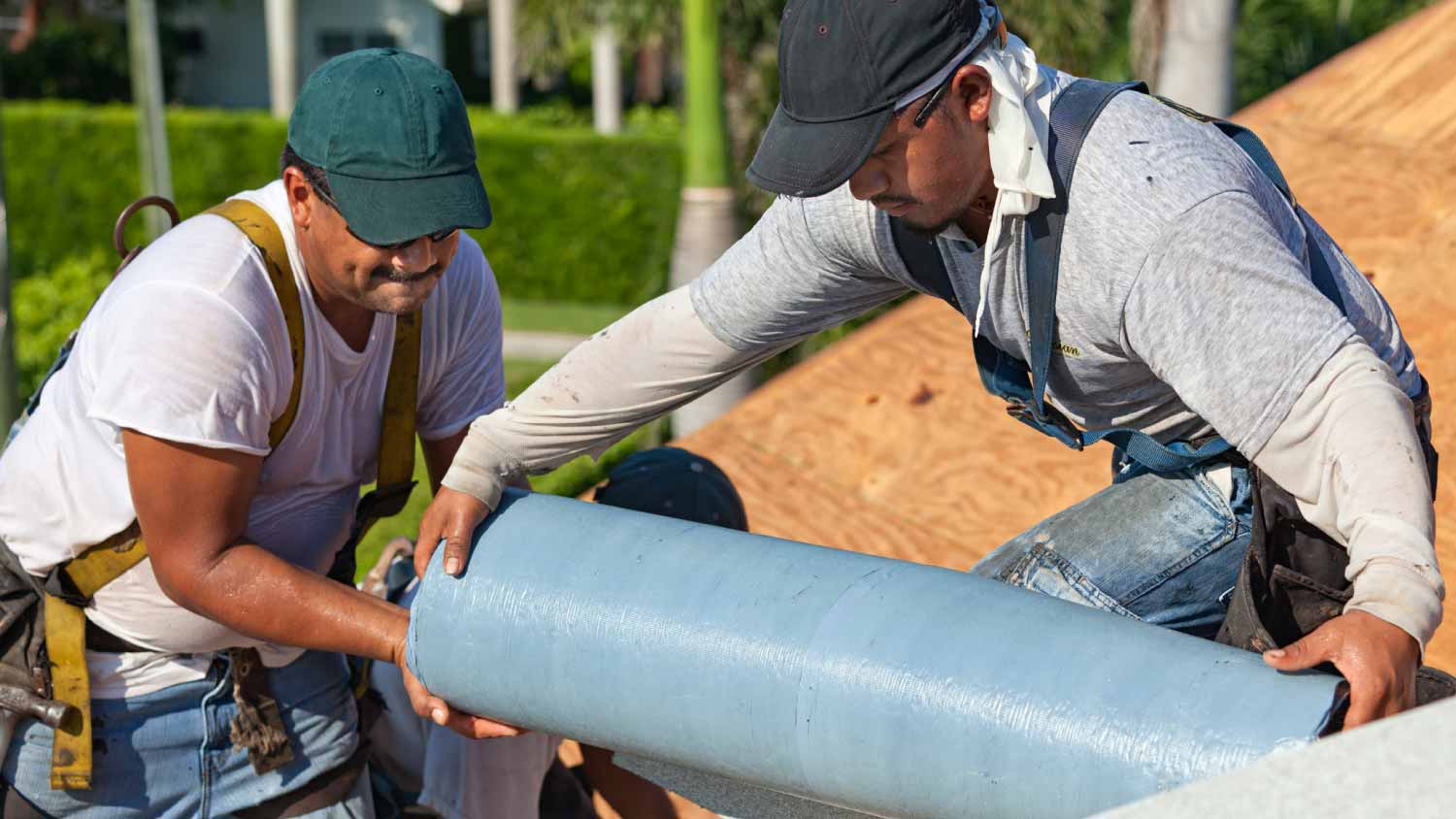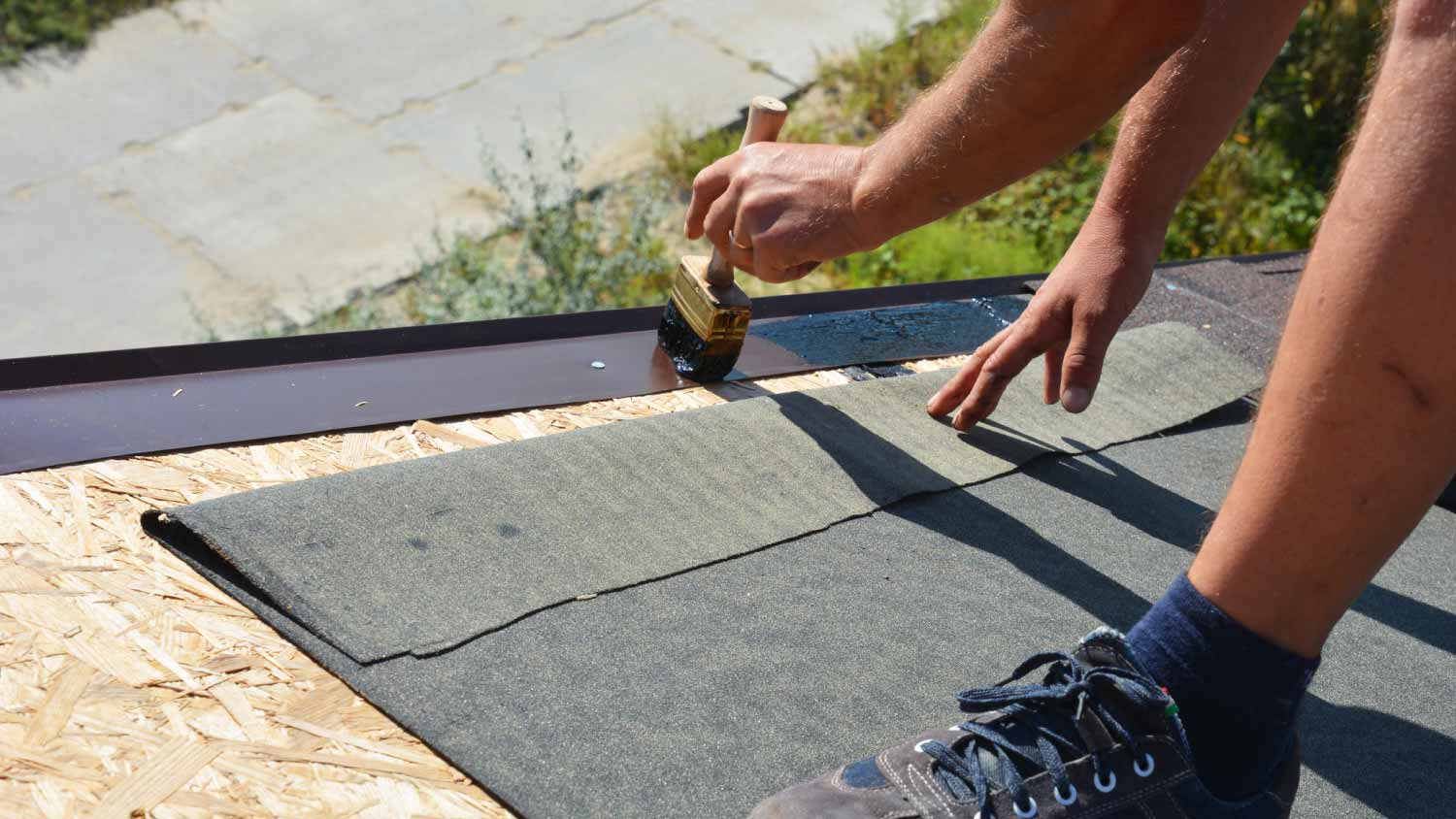The 3 Best Underlayments for Metal Roofs
The best protection for your roof


Metal roofs are becoming increasingly popular due to their durability and energy efficiency. However, selecting the right roof underlayment is essential to maximize the benefits of your metal roof. Roof underlayment acts as a critical barrier against moisture and weather elements, providing additional protection and extending the roof's life span. Learn about the best underlayment for metal roofs to choose the right one for your home.
| Type of Underlayment | Life Span |
|---|---|
| Synthetic | 25–35 years |
| Self-adhering membrane | 25–35 years |
| Felt | 20–30 years |
1. Synthetic

Synthetic roof underlayment offers superior performance and durability when paired with a metal roof. Made from materials such as polyethylene or polypropylene, synthetic underlayment is lightweight, tear-resistant, and highly durable. It provides excellent water resistance and is less prone to wrinkling, which can occur with felt underlayment. This option is the best roof insulation for hot climates.
Synthetic underlayment's price can vary quite a bit. On average, each square costs between $18 and $60.
| Pros | Cons |
|---|---|
| High-temperature tolerance | High cost |
| Durable | Limited breathability |
| Water-resistant | Potential compatibility issues |
| Slip-resistant | Requires professional installation |
Best for:
Areas with hot climates to increase metal roofing longevity
Areas with heavy rain and snowfall for increased water resistance
Increasing roof durability
2. Self-Adhering Membrane
Self-adhesive membrane underlayment, also known as peel-and-stick underlayment, offers robust protection for metal roofs against water infiltration and harsh weather conditions. Made from rubberized asphalt or modified bitumen, this underlayment adheres directly to the roof deck, creating a watertight seal that helps prevent leaks. Its self-sealing properties around nails and fasteners further enhance its ability to block moisture.
This type of underlayment is commonly made with rubber. The material is quite expensive and can range between $50 to $75 per square.
| Pros | Cons |
|---|---|
| Superior waterproofing | Highest cost |
| Self-sealing around fasteners | Difficult to reposition |
| Strong adhesion | Long prep time |
| Resistant to high temperatures | Limited breathability |
| Easy to install | Can potentially trap moisture |
Best for:
Climates with extreme hot or cold temperatures
Areas prone to severe weather conditions such as heavy rain or snowfall and high winds
Complex roof designs
3. Felt

Felt underlayment, often referred to as tar paper, is made from organic or fiberglass matting saturated with asphalt. For metal roofs, felt underlayment provides a basic level of protection against water infiltration and offers some cushioning for the metal panels. Available in different weights, such as 15-pound and 30-pound, the heavier options provide greater durability and resistance to tearing. On average, felt underlayment costs between $5 to $55 per square.
| Pros | Cons |
|---|---|
| Cost-effective | Prone to tears and wrinkles |
| Wide availability | Limited temperature resistance |
| Basic moisture protection | Low water resistance |
| Multiple weight options | Shorter life span |
| Offers cushioning | Heavy material |
Best for:
Budget-conscious homeowners
Areas with moderate climate conditions
Simple roof designs
How to Choose the Right Underlayment for a Metal Roof
When choosing an underlayment for your metal roof, you'll want to evaluate key features to ensure you're making the best decision. Below are the most important factors to consider.
Budget: If you're looking for a cost-effective solution and have a tight budget, felt underlayment is a suitable choice. For a mid-range budget where long-term durability is a priority, synthetic underlayment offers a balanced option. However, if you have a big budget and want the highest level of protection, self-adhesive membrane underlayment is the best choice.
Climate and weather: Felt underlayment is best suited for moderate climates with mild weather, providing basic protection in less demanding conditions. Synthetic underlayment is a versatile option that performs well across a range of climates, particularly in areas with high temperatures or moderate rainfall. For regions prone to severe weather, such as heavy rain, snow, and high winds, self-adhesive membrane underlayment offers the highest level of protection.
Roof complexity: Felt underlayment is well-suited for simple roof designs that lack complex features, providing basic protection and straightforward installation. For complex roofs with moderate complexity, synthetic or self-adhesive membrane underlayment offers greater versatility and ease of installation. These types of underlayment are best for roofs that feature numerous penetrations, valleys, or intricate shapes.
Longevity and durability: Felt underlayment is not the best longevity or durability option and is best suited for temporary or short-term solutions. Its life span ranges from 20 to 30 years. For homeowners looking for long-lasting durability and minimal upkeep, synthetic and self-adhesive membrane underlayment are both excellent choices and last 25 to 35 years.
Installation: Felt and synthetic underlayment are both simple and relatively quick to install. However, self-adhesive membrane underlayment requires careful installation and is best installed by a local insulation professional or roofer near you.
Can I DIY Repairing or Installing Underlayment?
Any kind of roofing work, including underlayment installation and repair, is best left to local roofing professionals. Roof work can be dangerous for homeowners, and improper underlayment installation will cause serious problems for your roof.
However, roof underlayment replacement costs range between $1,100 and $4,200, and you can save about half of the price if you have the necessary skills and experience to install it yourself. Felt underlayment is the most straightforward for DIY projects due to its ease of use. It requires basic tools and techniques, making it accessible for homeowners with some roofing experience.
Synthetic underlayment is slightly more advanced, but still manageable for experienced DIYers. Self-adhesive membrane underlayment demands the most skill and precision during installation. The peel-and-stick application can be tricky, as it requires careful alignment and a clean, dry surface. Mistakes can be challenging to correct once the adhesive has bonded.
If you do plan to tackle this as a DIY project, you'll need to know how long roof underlayment can be exposed. As a rule of thumb, underlayment can be exposed for up to six months, so ensure you follow timelines when preparing for your metal roof installation.





- Roofers
- Metal Roofing
- Roof Repair
- Roof Inspection
- Vinyl Siding Repair Contractors
- Flat Roofing Companies
- Commercial Roofing
- Emergency Roofing Companies
- Leaky Roof Repair
- Metal Roof Repair
- Business Roof Repair
- Flat Roof Repair
- Tile Roof Repair
- Slate Roofers
- Rubber Roofers
- Roofing & Siding
- Metal Roof Installation
- Affordable Roofing
- Roof Sealing
- Attic Ventilation Contractors
- 3 Roof Underlayment Types to Consider
- 7 Common Problems With Synthetic Roof Underlayment
- How to Install Sheet Vinyl Flooring Like a Pro
- How to Install Metal Roofing Like a Pro
- 30 Common Roofing Mistakes You Need to Know
- How to Build a Roof For Your Home, From Start to Finish
- 2024 Metal Roof vs. Shingles Cost Comparison Guide
- Types of Metal Roofs: Materials, Styles, and Fasteners
- Can You Walk On a Metal Roof Without Denting It?
- What to Know About Adding Wood Stripping Under Your Metal Roof










